
Tourist attractions in Greece Athens
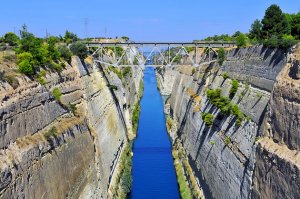
1 Corinth Canal
The Corinth Canal lies four kilometers east of modern Corinth. The idea of building a canal through the Isthmus of Corinth (which connects the Peloponnese to the rest of Greece) was conceived by the tyrant Periander in the sixth century BC. However, it was only completed during the period 1882-1893, after modern Greece gained independence. Involving an excavation up to 80 meters in depth, the canal is 6.3 kilometers long, 23 meters wide, and eight meters deep, and can take vessels of up to 10, 000 tons. The best view of the canal is from the bridge, which carries the road over it. An interesting feature is the movable bridge at the northwest end, which can be sunk below the surface, allowing smaller ships and sailing boats to pass through (paying a hefty tariff). However, it is too narrow for larger ships.
2 Ancient Corinth
Ancient Corinth is an important archaeological site, which has revealed many great finds. Once one of the most powerful cities of the Classical world, it came under Roman rule in 146 BC. It is here that St. Paul preached to the people of Corinth in AD 51-52, and his experience later inspired him to write the New Testament books of the First Corinthians and Second Corinthians, among the most quoted books of the Bible. Today, amid the archaeological excavations, you can see the ruins of various buildings including temples, a forum, baths, and a basilica.
Today, amid the archaeological excavations, you can see the ruins of various buildings including temples, a forum, baths, and a basilica.
3 Temple of Apollo
The most important monument in Ancient Corinth, the imposing Doric Temple of Apollo lies on a low hill and dominates the site. The temple was built around 540 BC, on the site of an earlier seventh-century-BC temple. Today, only seven monolithic limestone columns remain, but originally there would have been six along the front and back of the temple, and fifteen down each side. In the first century AD, the Romans moved the main entrance into the temple to the west (formerly it had been on the east), and they built stoas (colonnaded walkways) to each side of the temple.
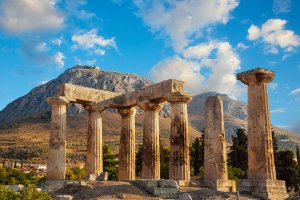
Corinth Archaeological Museum
Mosaic Floor of a Roman Villa in Corinth
This small museum provides a comprehensive view of finds from the Ancient Corinth archaeological site. Built in 1931-32 and extended in the 1950s, the museum has three display rooms and a large courtyard. The main attractions are Neolithic finds, typical Corinthian pottery and ceramics, mosaic floors, and numerous headless marble statues (the ancients would simply remove the head of a deceased leader from a statue, and replace it with the new leader's head). Exhibits are labeled in both Greek and English. The entrance ticket to the site is also valid for the museum.
5 Acrocorinth
Acrocorinth (Akrokórinthos) lies 3.5 kilometers south of Ancient Corinth. The ascent to the top of this impressive fortified hilltop (575 meters) is made easier by a road, which climbs to a point near the lowest gate on the west side. Acrocorinth was fortified in ancient times, and its defences were maintained and developed during the Byzantine, Frankish, Turkish, and Venetian periods, so that its walls now measure almost two kilometers in length. Within the fortress, a path leads to the highest point, to the former Temple of Aphrodite, which was converted into a mosque by the Ottoman Turks in the 16th century. From here, there are fine views of the Isthmus and the hills of the Peloponnese.
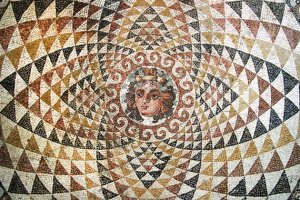 Acrocorinth Map
Acrocorinth Map
6 Loutraki
Overlooking the Gulf of Corinth, six kilometers northeast of Corinth, Loutráki is a popular seaside resort. Home to natural thermal springs, the Loutraki Spa is recommended for disorders of the urinary tract, kidney stones, gallstones, and gout. The method of treatment is bathing and drinking. The old town of Loutraki was destroyed by an earthquake in 1928 and today, it consists mainly of concrete hotels erected during the second half of the 20th century.
Modern Corinth
A powerful earthquake destroyed the old town of Corinth in 1858, which was rebuilt to a new plan on the coast overlooking the Gulf of Corinth, seven kilometers northeast of the ancient city. However, the new town had to be rebuilt yet again following another earthquake in 1928 and a great fire in 1933. Today's town consists mainly of modern concrete buildings, and everyday life centers on the cafés lining the square in front of the port. For tourists arriving from Athens and the rest of mainland Greece, Corinth is considered the gateway to the Peloponnese peninsula.
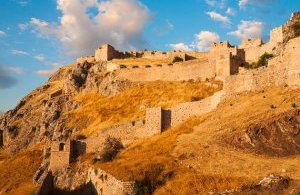

RELATED VIDEO


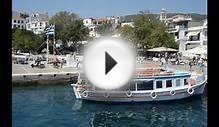
Share this Post
Related posts
Best tourist attractions in Greece
The island of Santorini (Thíra) is most impressive when approached from the sea as you sail into the massive caldera (sea-filled…
Read MorePlaces to see in Athens Greece
Welcome back to our ‘Best Kept Secrets’ blog series. Last week we ran through . This week we’ll give you the lowdown on what…
Read More










